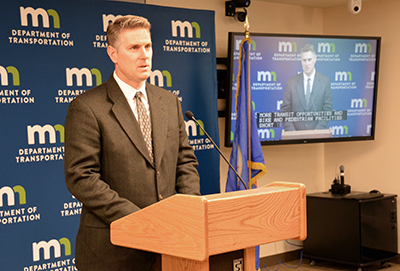
Michael Beer, Metro District construction engineer, provided detail about some of the more than 70 projects that will be underway in the Twin Cities this year. Beer was part of MnDOT's annual news conference that announced a $1.1 billion statewide construction program consisting of 253 road and bridge projects. The news conference was held in MnDOT's new Training, Emergency and Conference Center in the basement of the Transportation Building in St. Paul. Photo by Sue Roe |
While winter refused to release its grip on Minnesota, spring was officially marked April 4 at MnDOT’s annual construction and maintenance season kickoff event.
“It’s pretty obvious that construction is not going to get going this week,” said Sue Mulvihill, deputy commissioner and chief engineer, at the news conference in St. Paul. “Many projects were scheduled to start but they’ll be backing up a little bit as we deal with the snow we’ve had over the past couple of days.”
Commissioner Charlie Zelle announced $1.1 billion in state road and bridge projects that will be worked on across Minnesota this year. The 253 projects, many of which are already underway, will help keep the state’s roads and bridges in good working condition, improve safety for motorists and support thousands of construction jobs across the state.
“These projects are critical investments in Minnesota’s aging transportation system,” Zelle said. “We will repave roads, repair and paint bridges, replace culverts and rehabilitate structures such as the Stillwater Lift Bridge.”
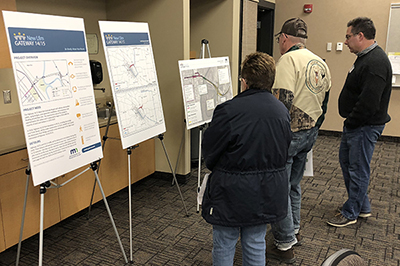
District 7/Mankato officially kicked off its 2018 construction season a few weeks early on Feb. 21 when it hosted a public open house at district headquarters to talk about big projects on Hwy 14, Hwy 169 and Hwy 22. Staff provided information about construction schedules and traffic impacts, as well maps of the highway corridors. Photo by Anne Wolff, District 7 public affairs |
The commissioner also announced 49 multimodal projects valued at $32 million that will also be underway this year. These include airport, port and railroad projects that are outside of the state road construction program.
Despite the large construction program this year, Zelle said the long-term transportation funding picture remains bleak compared to the system’s needs. In 2017, Governor Dayton and the Legislature provided an additional $640 million in trunk highway bonding over the next four years as well as $164 million in cash. This additional funding will reduce Minnesota’s annual $600 million transportation funding gap by $200 million for each of the next four years. However, Minnesota’s $600 million annual funding gap will resume beginning again in 2022.
Michael Beer, Metro District construction engineer, noted that construction crews would be working hard on more than 70 projects in the Twin Cities alone.
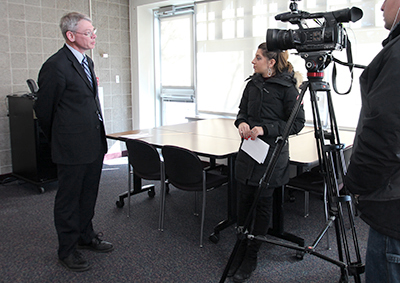
Duane Hill, District 1 engineer, discussed area construction projects with FOX 21 TV at a construction kickoff news event held April 4 in Duluth. Hill said that motorists should plan ahead for travel, pay attention in work zones and use the 511 app. Photo by Beth Petrowske, District 1 public affairs |
“Long-term that means better roads and bridges, reduced congestion, improved safety, and more transit opportunities and bike and pedestrian facilities,” he said. “Short-term that means detours, work zones and sometimes difficult travel for you.”
“Construction is not going to leave any part of the state untouched this summer,” said Col. Matt Langer, chief of the Minnesota State Patrol. “Our simple message is: we want people to slow down and pay attention. And that’s as simple as it gets for work zones.”
Langer added that drivers should know that “the Zipper Merge really works. It is the most efficient way to get through the work zone.”
District staff statewide, some partnering with cities or counties in their area, also spoke with their local reporters and provided information about the projects in their region.
2018 road and bridge construction
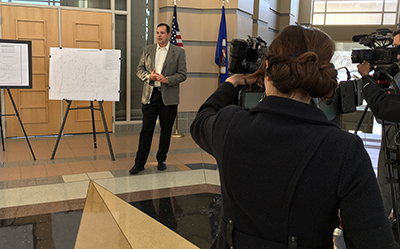
Mark Schoenfelder, District 6 assistant district engineer for program delivery, talks with Rochester media during a joint news conference with the city of Rochester and Olmsted County. Photo by Mike Dougherty, District 6 public affairs |
This year’s construction program features a number of projects in the Twin Cities metro area, including:
- Interstate 35W@94 – Upgrade infrastructure, improve transit service on I-35W and Lake Street, and provide better access into the Lake Street Business District.
- Highway 169 Belle Plaine – Repair or replace concrete pavement, construct a Reduced Conflict Intersection and install cable median barrier between Jordan and Belle Plaine
- Highway 169 Champlin – Replace Elm Creek bridges, realign Highway 169 between the Mississippi River and East Hayden Lake Road, and construct a pedestrian/bicycle underpass beneath Highway 169 at West River Road
- I-35 North Metro split – Resurface six miles of interstate from just south of the I-35 split at Forest Lake to a half mile north of Highway 8 and replace three bridges
Greater Minnesota will also see a lot of construction work this summer, including:
Northern region
- I-35 Snake River – Construct two new bridges at Snake River and resurface seven miles of I-35
- Highway 38 – Resurface pavement, provide intersection improvements, and replace 41 culverts
- Highway 61 Two Harbors – Replace signals in Two Harbors, add turn lanes, resurface highway, make sidewalk and accessibility improvements, create new entrance at Campground Road
- Highway 194 – Reconfigure lanes to eliminate current weave, rehabilitate bridges, repair concrete pavement and storm sewers, and make accessibility improvements
- Highway 72- International Bridge – Work with the Ontario Ministry of Transportation to conduct a preliminary design and environmental study for the replacement of the Baudette/Rainy River International Bridge
- Highway 2 – Replace Kennedy Bridge deck
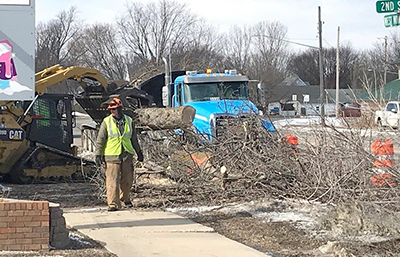
Tree removal in Glenwood took place last month in preparation for this year's Complete Streets project. Photo by by Tim Douglass, Pope County Tribune |
Central region
-
Highway 10 Elk River bridge – Reconstruct the bridge over Lake Orono and resurface road west of Joplin
- Highway 10 Big Lake to Clear Lake – Reconstruct 14 miles of eastbound road surface, including shoulders, and add Reduced Conflict Intersection at County Road 23 in Becker
- Highways 28, 29, 104 in Glenwood – Resurface highways, reconstruct downtown using a Complete Streets concept, add new signal system, make accessibility improvements and mitigate flood-prone area near Pope County Fairgrounds
- US 71 north in Kandiyohi County – Resurface highway, construct turning and bypass lanes, and construct a pedestrian underpass
- Highway 19/Highway 71 in Redwood Falls – Construct two-way left turn lanes, install new signal system at County Road 101, and make accessibility improvements
Southern region
For a complete list of projects by highway, visit www.mndot.gov/roadwork/current.html. Project page information includes construction schedule, traffic impacts, maps, benefits and costs.
To see the April 4 news conference video, visit https://www.ustream.tv/mndot. Media briefing materials, including lists of projects by districts, can be found at www.mndot.gov/construction/. |



